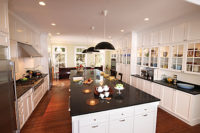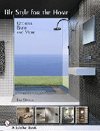“The client loved their current home, which they have lived in for many years and intend to stay for many more, so they decided that the leak in the existing master bathroom shower would be the excuse for envisioning for themselves the master bath that they never had,” explained architect Kevin Yoder, AIA, LEED AP of k YODER design, llc in Philadelphia. The architect explained that the former configuration of the master bath was long and very narrow — only 3 x 10 feet wide with a small shower at the far end. The remodel not only included expanding the size of the space, but also adding luxury amenities such as a bidet and “his and hers” towel warmers.
The design intent was to create an aesthetic that would be light and tranquil, including a skylight in the shower and a large rain showerhead that hovers below the skylight to reinforce that concept. Lithoverde, a product made of 99% recycled stone, was chosen for the accent and focal walls in the master bath. The material was utilized as tiles measuring 12 x 24 inches, and they were installed in a brick bond pattern.
The limestone-based product, which was manufactured by the Italian company Salvatori and supplied by Stone Source, is created by dry laying stone scraps in layers to form a block, which is then infused with a soy-based polyamide binder to create a tight bond. The block can then be handled like any other block of stone, according to the manufacturer.
“The client and I decided fairly early in the materials selection process that we wanted to achieve a narrow, horizontal stacked stone look with the bathroom’s feature wall tiles to achieve a spa-like serene, but organic, warmth to the tile,” Yoder explained, adding that his inspiration for the design was the iconic Therme Vals Hotel and Spa in Switzerland.
“In a moment of client/architect synergy, the client mentioned that they had recently stayed at a hotel in Germany with a similar tile installation that they really thought was attractive.”
In addition to Lithoverde, 12- x 24-inch porcelain floor tile, which also flows into the curbless shower with linear drain, was selected. Beige-colored 6- x 24-inch porcelain tile was used for the shower end walls and the wall behind the vanity. “It has a soft, subtle visual texture that complements the Lithoverde,” said Yoder. “The 6- x 24-inch tiles reinforce the horizontals and are installed in a stacked bond to give the design a classic modern feel, and also, it doesn’t dominate the active nature of the Lithoverde random horizontals.”
|
Master Bath Remodel Philadelphia, PA |
|
Designer: k YODER design, llc Philadelphia, PA |
|
Contractor: Henry/Casadei Construction, Philadelphia, PA |
|
Stone Manufacturer: Salvatori, Italy |
|
Stone Supplier: Stone Source, Philadelphia, PA |
The project’s biggest challenge proved to be avoiding the random placement of the horizontal joints in the Lithoverde to “almost” line up with adjacent porcelain tile joints. “Since it would not be possible to align them, we wanted to try to deliberately adjust the field of the Lithoverde tile vertically so that the joints were significantly not aligned with the adjacent 6- x 24-inch pieces and therefore avoided having them look like we tried to align them but couldn’t,” explained Yoder.
The installation
Overall, the stone and tile installation went very smoothly in large part due to the tile setter’s exacting skill and attention to detail. With respect to the Lithoverde, the architect attributes the smooth installation to the 12- x 24-inch size of the tiles and the decision to do an offset brick pattern. “We worked with Carolyn, the tile setter, and kept the tile joists as tight as possible and matched the grout to the color of the binder between the individual smaller pieces of stone within a given tile,” he explained. “It is very difficult to see that the horizontal random staggered pattern was actual created by the larger 12- x 24-inch size tile.”
When doing a dry layout with the actual tile on the floor, Yoder explained that they noticed an “unanticipated” condition. “Because of the way the material is fabricated, within a given package of tile, quite often the layout of the individual stone pieces and the vertical spacing of the horizontal joints were identical,” said the architect. “It might have been feasible to align these intermediate stone horizontal joints and achieve a very regular linear look, but the design intent was to have a random horizontal ashlar pattern so we chose to deliberately not align the horizontal joints from tile to tile by mixing up the boxes and flipping some of them 180 degrees to avoid that alignment and repeat.”
In total, the project took approximately five months to complete. “The feedback has been very favorable, having been featured in a local Philadelphia Magazine blog ‘Property’ and a Philadelphia Magazine Facebook post entitled ‘Serious Shower Envy.’










